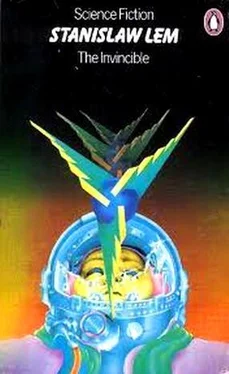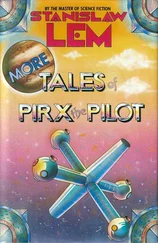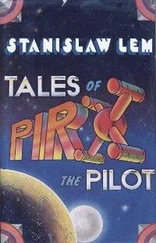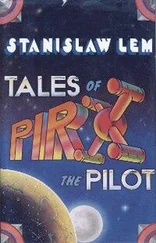Rohan called the satellite launching pad via intercom. They were announcing the start of the first pair of photo satellites, to be followed by additional launchings within the hour. In another twenty-four hours the Invincible’s crew could expect to receive a detailed photographic survey of the entire equatorial zone.
Rohan sat down in front of the control panel. No one would ever have gotten him to admit that he felt the same thrill at the light effects whenever a satellite was put into orbit. First the control lamps of the booster rocket would flare up with red, white and blue lights. Then the starter automat would begin countdown. As soon as its ticking ceased, a slight tremor would shake the entire ship’s body. At the same time a bright phosphorescence would illuminate the desert that until that moment had lain like a dark shadow on the videoscreen.
A low rumble spread throughout the whole cruiser, down to the lowest decks, as the tiny projectile shot out of the ramp at the ship’s nose. The Invincible was bathed in a sea of flaming light. The booster rocket fled skyward, its glow a feeble flicker on the slopes of the dunes, which Christmas tree: they indicated that the burnt-out rocket could no longer be heard — the instrument panel was racked by a sudden feverish trembling. The oval-shaped ballistic control lights flashed out of the dark, and were welcomed with friendly encouraging nodding by the shimmering lights of the remote control steering, like bits of mother-of-pearl. Then colorful signals lit up like a Christmas tree: they indicated that the burntout rocket stages had been jettisoned. Finally the rainbow effect created by the constant flickering and shimmering was blotted out by a stark white rectangle. This was the sign that the satellite had reached its orbit. In the center of this glittering white area a small gray island emerged, gradually condensing its vague outlines to form the number 67, the altitude at which the satellite was circling the planet.
Rohan quickly checked out the orbital parameters, but perigee and apogee were close to the values calculated beforehand. There was nothing else for him to do here. He compared the time aboard the Invincible, 18:00, with current local time: it was 23:00. For a brief moment he closed his eyes; he looked forward to this excursion to the seashore, for he preferred working on his own. He felt hungry and tired. Rohan deliberated whether he should take a pep pill, but then decided to have a real meal. As he rose from his seat he realized how exhausted he actually felt. The momentary shock caused by this discovery gave him a new burst of strength. Rohan took the elevator down to the mess hall. His crew was already there waiting for him: the two drivers of the air-cushioned hover trucks. He was fond of the one name Jarg, because of his pleasant disposition. There were also the oceanographer Fitzpatrick and his two colleagues Broza and Koechlin. They were just finishing supper as Rohan ordered some hot soup and helped himself to bread and a few bottles of nonalcoholic beer which he took from an automatic dispenser built in the wall. He placed everything on a tray and walked over to the dining table. At this moment a slight tremor shook the floor. The Invincible had launched another satellite.
The commander had not been in favor of any nocturnal expeditions. Shortly before sunrise, at 5:00 Am. local time, they started out on the journey. They employed the usual precautionary measures, advancing in the painfully slow marching order that was generally known as the “funeral procession.” A group of energo-robots led the way while others brought up the rear. They had erected an ellipsoid force field for the protection of the entire group, for the all-purpose vehicles, the cross-country jeeps containing radar and radio installations, the mobile kitchen, the trailer with airtight living quarters, and the small carriage on caterpillar tracks on which their laser beam sender had been mounted.
Rohan and his three experts climbed into the energo-robot at the front of the train. It was a rather tight squeeze, but this way they had at least the illusion of a relatively normal ride. The entire train moved at the speed of the slowest vehicles — the energo-robots — which did not contribute to the men’s comfort. The caterpillar tracks groaned and crunched through the sand. The turbo engines maintained a steady hum, reminding Rohan of a huge swarm of persistent flies. Cool air blew from the air conditioning duct that opened directly behind their seats. The energo-robot rocked back and forth like a big sloop making its way through heavy seas. After a while the black needle of the Invincible sank below the horizon. For some time they drove across the monotonous desert while the sun rose, blood red and cold.
The landscape changed. There was no longer so much sand. Instead rocky shelves rose at a slant from the ground. Many detours were necessary. Conversation was impossible because of the noisy engines and the oxygen masks covering their faces. Conscientiously the men scanned the horizon, again and again finding the same picture: huge rock piles and big chunks of well-weathered stones. Finally the ground began to slope downwards. At the bottom of a basin-shaped valley they discovered a small brook with a narrow trickle of water that glittered in the red light of the dawn. Both banks were lined with wide deposits of round, polished stones, indicating that the brook occasionally must carry considerable amounts of water.
They halted briefly and examined the water. It was limpid but rather hard, and contained ferric oxide and tiny traces of sulphide.
They continued their march at a faster pace than before, since the caterpillar tracks could make better headway on the rocky ground. To the west rose low rocky cliffs. The last vehicle maintained communication with the Invincible. The radar antennae kept turning; the observers sat in front of their radar screens, constantly adjusting their headsets and chewing grains of energy concentrate. Once in a while a stone was flung out from beneath the turbo-drive vehicles as if by a tiny tornado, propelling it high up the stony slopes. Then their way was blocked by softly arching hills. Without slowing down they picked up a few rock samples. Fitzpatrick called out to Rohan that the gravel-like soil might be of organic origin.
Finally, as they sighted the blue-black surface of the ocean, they also found some limestone formations. They drove toward the shore. The ground was now covered with small, flat stones over which the vehicles proceeded noisily. The hot vapors from the motors, the screeching of the caterpillar chains, the hum of the engines were all instantly stifled as they halted suddenly about one hundred yards offshore. The green-gray ocean stretched out ahead of them, looking no different than the Atlantic Ocean on Earth.
Now a rather complicated maneuver had to be executed: the energo-robot in front of the column had to advance deep into the water in order to maintain the protective energy screen above the whole group. The machine was made watertight, then it rolled into the waves, steered by remote control from another robot. The first robot sank slowly deeper and deeper, disappearing underneath the surface, and could be seen only dimly as a dark spot. Then, obeying a radio signal, the immersed colossus pushed its Dirac emitter above the surface of the water. As soon as the energy field had become stabilized, arching an invisible hemisphere over a part of both the shore and the ocean in front of it, the men could start their examinations.
The salinity of this ocean was slightly less than that of terrestrial sea water, but the results of the analysis were anything but sensational. Two hours later they knew little more than before, so they steered two television probes far out over the ocean, observing their paths on television sets. Not until the probes had disappeared on the horizon did the crew receive signals that were of any interest to them. Some living organisms inhabited the ocean; they resembled fish. As the probes approached, the creatures scatterd with enormous speed, seeking shelter in the depths of the ocean. Sonic depth finders located the first sign of organic life on Regis 150 yards below the surface of the ocean.
Читать дальше











